|
A cookbook spiced with local flavours and childhood memories |
||||
| Book facts: Serendip- My Sri Lankan Kitchen by Peter Kuruvita. Murdoch Books. Price: Rs. 3,800 | ||||
| By Renuka Sadanandan | ||||
| a??When our houseboy Nehal brought us the crusty bread from the bakery next door it was still steaming hot. I used to love cutting thick slices of the bread and putting spoonfuls of pol sambal on it- it was delicious.a??
Reading Peter Kuruvitaa??s cookbook is like taking a stroll through memories past for entwined with the many tastes of his homeland is the story of the Kuruvita clan and his boyhood memories of steaming curries and all the foods of his growing years. His memories of Sri Lankan food come from his grandmothera??s kitchen, the visitors to it (like the uncle who loved acting like a yakka) and the people behind the mouthwatering curries who spice the narrative, as colourfully as the recipes theya??ve left behind.
Now a sought-after celebrity chef who runs Sydneya??s harbour front Flying Fish restaurant, Peter tells the story of how he overheard two women at the Galle Literary Festival bemoaning the lack of a good Sri Lankan curry reference book and so was inspired to work on his own. He relates how he organised a gathering of the ladies of the Kuruvita clan, something that hadna??t happened in many years and had them cook. This they did with gusto, though rarely finding consensus on their recipes. The best recipes are all handed down from generation to generation and so each familya??s take on them could be different, he says. But before you reach the recipes proper in this enticing cookbook, readers encounter the Kuruvitas, in particular Petera??s father, Wickramapala Kuruvita who had left Ceylon as a young man to seek his fortune and was now returning after some years in London with his pregnant Austrian wife Liselotta Katharina, two children and a cousin in tow in a Austin Minibus overland from England through the mountains and deserts, the searing heat of India, to their ancestral home in Dehiwela. The introduction gives a graphic account of how the last leg of the journey from Danushkodi in South India to Colombo required every bit of his fathera??s ingenuity to get the minibus on board the ferry. Finding that a cyclone had washed away the pier, Kuruvita Senior organised two flimsy dugout canoes at the seaside and made a makeshift barge on which the minibus was driven and then towed out to the ferry .Thus the family arrived and was absorbed seamlessly into the extended family. Peter pays loving tribute to the family matriarch, his a??achia?? Emanona Weerasekera Kuruwitage while recounting how she had vile-tasting or very painful traditional Sri Lankan medicine ready whenever he cut or hurt himself, which was all too frequent.
The family compound was more than 200 years old and contained two houses and a large engineering workshop. During Petera??s childhood, it was home to six children and three sets of parents, he recalls in the book and the children were nourished on a diet of love and good food, which has stayed fresh in his mind. a??My achia??s kitchen,a?? he writes, a??was the centre of our familya??s universe. In it, there were love matches, fights, drunken uncles, weddings, special full moon rituals, wonderful food and the travelling chefs who would arrive in bullock carts with their massive pots and cook for hundreds. I feel very lucky to have been given some of the recipes that were nurtured there.a?? His grandmothera??s food remains the cornerstone for his style of Sri Lankan cooking, he says, no mean admission for a well-known chef. The book, a coffee-table volume published by Murdoch Books is rich in design elements, its jacket cover, a lavish montage of pictures redolent of the lushness of the island. The cover in fact was used on the Murdoch catalogue of its publications for 2009. But however tempting the cover, it is the contents that must grab onea??s attention and the recipes do not disappoint, though the spellings sometimes do. Peter starts with the basics, the spices and the curry powders that are the foundation of any Sri Lankan dish. But for the foreign reader, this may prove daunting for as he says an ordinary Sinhalese curry can contain up to thirteen herbs and spices: chillies, coriander, cumin, curry leaves, fennel, fenugreek, garlic, ginger, lemongrass, lime, onion, pandanus leaf and turmeric. Curries- all the traditional meat, fish, vegetarian plus seafood, Sinhalese and Tamil plus regional food like the wildboar curry credited to a lodge owner in Arugam Bay where the family spent the occasional holiday, Point Pedro vadai, given a seafood cracker flavour by inserting a prawn into it, krill sambol from Kosgoda where Petera??s uncle who was married to a German lived, make up chapters in the book. The places too get special mention, the beef stall at the end of Hill Street and the neighbourhood bakery where the ladies sent their rich cake to be baked for in those days few had ovens large enough for big quantities like those required for a wedding. Like the bread and pol sambol that any true Lankan cannot do without, the book will resonate with all who remember long and leisurely family meals, where hospitality and food were abundant and the time when food was cooked with love and not with prepackaged ingredients. Fittingly, the final chapter is dedicated to his father and written with so much emotion that the reader forgets momentarily that it is a cookbook that is being read. But the spice soon returns when Peter turns to his fathera??s cooking skills:a??He thought if you did not sweat while eating a curry it was not right- at every meal, at least one of the curries or condiments had to have the fire of the devil in it.a?? Peter Kuruvita will be in Sri Lanka later this month for the Galle Literary Festival. His book is now available at the Lake House Bookshop and other book stores. http://www.sundaytimes.lk/100110/Plus/plus_18.html |
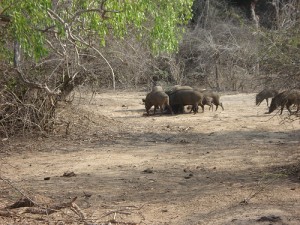
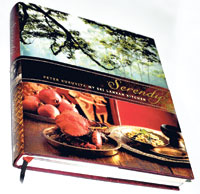
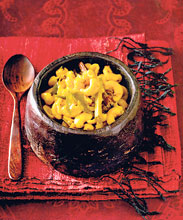
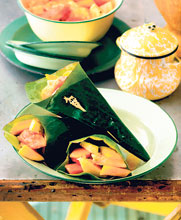
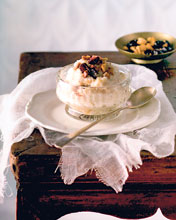
 Arugam Forum
Arugam Forum Arugam Photo Galleries on Picasa
Arugam Photo Galleries on Picasa Old Website
Old Website Press Coverage
Press Coverage Surf Forecast for Arugam Bay
Surf Forecast for Arugam Bay
0 Responses to “Wildboar Curry @ a lodge in Arugam Bay”